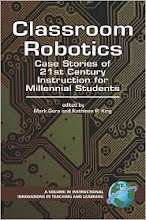Teachers see benefits of robots in classroom
Robot helpers
Chanute Elementary teachers who
witnessed a desktop robot leading a multi-stepped math lesson say they
can envision several ways a social robot could benefit student
learning.
The smart robots designed by Van
Robotics are being developed as a “study buddy or tutor” that will guide
students through a lesson, adapt lessons to a student’s ability,
respond to a child’s performance with words of encouragement or notice a
lack of focus and redirect the student, or ask if the child needs to
take a break.
“The demo was great in guiding the
students through a step-by-step process in completing multistep
problems,” said CES Title reading teacher Patty Small. “As long as the
technology holds the students’ attention, it could benefit them by
teaching them to become automatic and fluent in this process and any
other problem-solving activities that it may address.”
“I would really enjoy trying this out
in my classroom with kids that need some one-on-one time,” said second
grade teacher Nikki Jacobs, especially for those occasions when teachers
feel they have tried everything they know to help a child, but it’s not
working.
“As far as helping students with
Autism, the possibilities would be endless,” said fifth grade teacher
Madison Mitchell. “I could see it being used for social group, speech
pathology, reading and writing individualize lessons, and really lending
itself to the child’s brain ability.”
Shelly Kuhn, a speech pathologist who
works with children at CES and Humboldt, has seen the results of using
her robot Aisoy as part of her speech and language sessions.
“With my students I have seen
increased attention to task, a reduction of off-task behaviors, improved
social interaction, and working for longer amounts of time before
scheduled breaks,” Kuhn said.
With the support of administration at
the ANW Education Cooperative and a USD 413 Foundation grant, Aisoy
joined Kuhn’s speech-language program two years ago.
“Research has shown that children on
the Autism Spectrum have difficulty understanding social language. When
we speak, students must focus not only on the content of the messages
but also try to understand the nuances which accompany our speech, such
as pitch changes, volume, inflection, gestures, eye contact and many
facial expressions,” Kuhn explained. “That can be very overwhelming for
them. With the robot, students can focus on the content of the message
first and gradually learn the social factors of communication in a
non-threatening approach.”
Read the full article at its source: http://www.chanute.com/news/article_f0a011e2-a95b-11e7-82bd-7f5d6839ced7.html
Read the full article at its source: http://www.chanute.com/news/article_f0a011e2-a95b-11e7-82bd-7f5d6839ced7.html



No comments:
Post a Comment